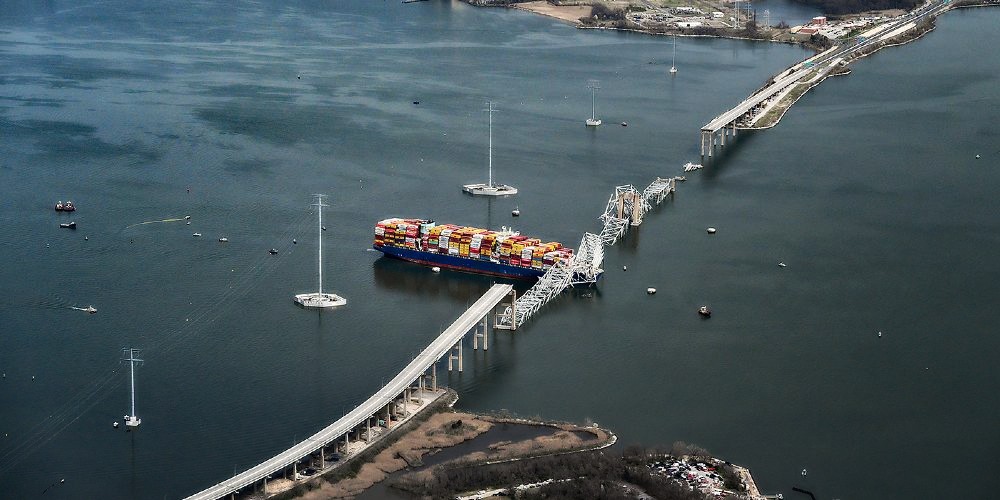![]() (DCNF)—The effort to rebuild the recently collapsed Francis Scott Key Bridge near Baltimore, Maryland, could quickly turn into a years-long quagmire as a result of environmental red tape under the Biden administration, experts told the Daily Caller News Foundation.
(DCNF)—The effort to rebuild the recently collapsed Francis Scott Key Bridge near Baltimore, Maryland, could quickly turn into a years-long quagmire as a result of environmental red tape under the Biden administration, experts told the Daily Caller News Foundation.
The Baltimore Bridge was struck by a container ship navigating the Patapsco River out of the Port of Baltimore in late March, sending several cars and workers into the water and rendering the passageway unusable. It is unknown exactly how long the bridge could take to rebuild, as officials could expedite the process, but experts warned the DCNF that government red tape, such as environmental reviews filed by government entities or environmental activists, could slow down its construction after debris is cleared from the site and new plans for a replacement bridge are drawn up. +
“Beef Steak” – our most popular survival beef product – is on sale now.
Promo code “steak40” at checkout for 40% off!
“If the bridge gets special regulatory treatment, then five years is a reasonable timeline,” Ryan Young, senior economist at the Competitive Enterprise Institute, told the DCNF. “There is some hope for this, based on last year’s collapse of a stretch of I-95 near Philadelphia. It reopened in 12 days, mostly thanks to red tape being waived. It would have taken months otherwise. Of course, that was a much smaller project.”
Following the disaster, the Biden administration announced that it would be sending $60 million to the city of Baltimore to assist in the clean-up and rebuilding, far from the sum needed to rebuild the project fully. President Joe Biden has also pledged to completely cover the cost of reconstructing the bridge, pending Congressional approval, according to Reuters.
An official cost of a new bridge has yet to be announced, but some estimates are around $500 million up to $1 billion, depending on the size and design of the project, according to the AP. The original bridge cost just $60.3 million to build, according to CNN.
“The Key Bridge recovery can take multiple paths, but the two we need to be keeping an eye on are first, where is the red tape around environmental historical preservation bogging down the efforts to help this community recover, and second, what coordination is occurring at the federal level to effect a more resilient recovery for the community, who’s looking at what the vision is, long term,” Brian Cavanaugh, visiting fellow in the Border Security and Immigration Center at the Heritage Foundation, told the DCNF.
A similar bridge disaster occurred in 1980, when a freighter struck the Sunshine Skyway in Tampa Bay, Florida, according to The Associated Press. Construction on a new bridge finished 7 years later, in 1987, 19 months later than it was originally projected to be complete and $20 million over budget.
“Federal and state regulations, including in Maryland, give NIMBYs and environmentalists a lot of ways to block projects,” Young told the DCNF. “Hopefully the Key Bridge’s high visibility will help them restrain their worst anti-development impulses, but that is no guarantee.”
Many large infrastructure projects are often bogged down by environmental reviews, such as California’s high-speed rail project, which has spent more than $600 million on environmental reviews since it was approved by voters more than 15 years ago.
“My fear here is that people can generate environmental reviews that they flag concerns for, say the oyster population or if there’s a bird that breeds in the Patapsco River or water quality,” Cavanaugh told the DCNF. “All these things could easily be triggered through a federal review process and would drag on. Those reviews are not always efficient. The efficacy of those is to be determined by others, but they’re certainly not expedited.”
The Biden administration has expanded the national environmental review framework, rolling back changes that the Trump administration made to the National Environmental Policy Act (NEPA), which requires federal agencies to review the environmental impacts of projects before approval. If the federal government remains involved in the project, environmental reviews may bog down the process, as the average NEPA environmental impact statement between 2010 and 2018 took 4.5 years to complete, halting construction completely, according to the White House’s Council on Environmental Quality.
“The rebuilding cost will almost certainly be higher than the original bridge, for several reasons, though I have no idea by how much,” Young told the DCNF. “A good rule of thumb is Edwards’ law—costs are usually at least double what officials first propose.”
Some analysts say that after cleaning up the site, creating new plans and building the bridge, the whole process could take up to a decade, according to WYPR, an outlet local to Baltimore. It took six years to build the Transcontinental Railroad.
“I fear that the cost of regulations is going to be more impactful than people are giving it credit for,” Cavanaugh told the DCNF. “Depending on what design they go with, like what birds fly in the area or what fish are in the Patapsco River, the cost of studying that and mitigating the negative impacts would be a problem. The mitigation measures to make the bridge more resilient and safe are going to be an added cost. But that’s an added cost not captured by inflation for any bridge built today.”
- Gold SKYROCKETED during Trump’s first term and is poised to do it again. Find out how Genesis Precious Metals can help you secure your retirement with a proper self-directed IRA backed by physical precious metals.
The Maryland Governor’s Office deferred the DCNF to statements made in previous press conferences. The White House did not immediately respond to a request to comment.



